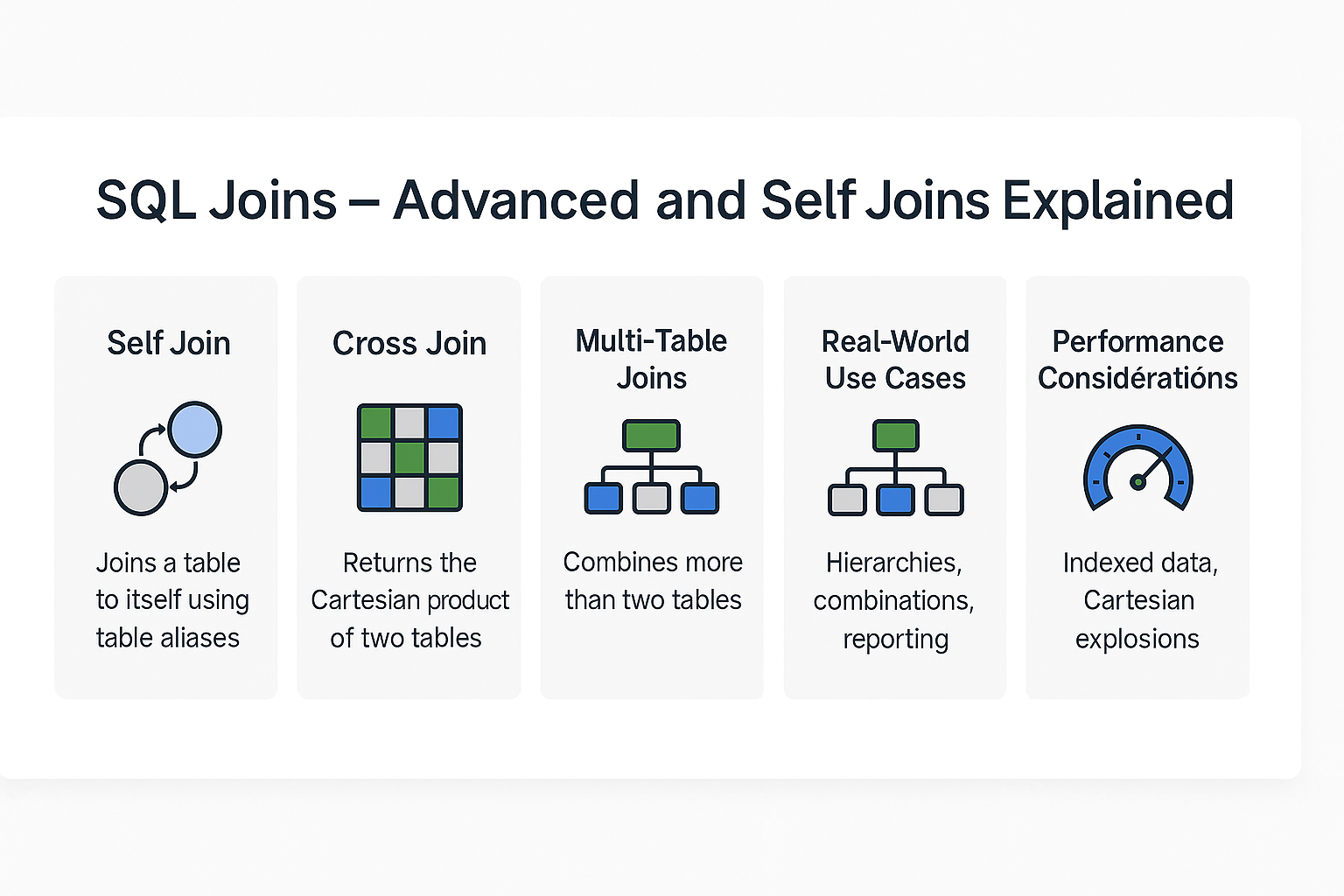Introduction
Advanced SQL joins extend beyond simple INNER and OUTER joins to handle more complex relationships and use cases. Self joins and multi-table joins are critical for hierarchical data and advanced reporting.
Why Advanced Joins Matter
- Handle hierarchical and recursive relationships.
- Combine multiple tables for complex queries.
- Enable advanced analytics and reporting.
Real-world analogy:
Imagine an organization chart. A self join is like linking employees to their managers within the same table, enabling hierarchical relationships.
Core Concepts
Self Join
A self join joins a table to itself, using table aliases to differentiate instances.
Cross Join
Returns Cartesian product of two tables, useful for generating combinations.
Multi-Table Joins
Combining more than two tables using different join types.
SQL Examples
Sample Table: Employees
| emp_id | name | manager_id |
|---|---|---|
| 1 | Alice | NULL |
| 2 | Bob | 1 |
| 3 | Charlie | 1 |
| 4 | David | 2 |
Self Join Example – Employee-Manager Relationship
SELECT e.name AS employee, m.name AS manager
FROM employees e
LEFT JOIN employees m ON e.manager_id = m.emp_id;
Result:
| employee | manager |
|---|---|
| Alice | NULL |
| Bob | Alice |
| Charlie | Alice |
| David | Bob |
Cross Join Example
SELECT c.name AS customer, p.product_name
FROM customers c
CROSS JOIN products p;
- Generates all combinations of customers and products.
Multi-Table Join Example
SELECT c.name, o.order_id, p.product_name
FROM customers c
JOIN orders o ON c.customer_id = o.customer_id
JOIN products p ON o.product_id = p.product_id;
Real-World Use Cases
- Self Join: Organization hierarchies, friend networks, recursive relationships.
- Cross Join: Generating test data or combinations.
- Multi-Table Joins: Combining customers, orders, and products for reporting.
Common Mistakes and Anti-Patterns
- Forgetting aliases in self joins: Leads to ambiguous column errors.
- Using cross joins unintentionally: Creates massive result sets.
- Joining too many tables in OLTP queries: Hurts performance.
Performance and Scalability Implications
- Self joins on large tables can be expensive; consider indexed hierarchical data.
- Cross joins should be used cautiously to avoid Cartesian explosions.
- Optimize multi-table joins with proper indexing and query planning.
RDBMS Comparison
| Join Type | PostgreSQL | MySQL | Oracle |
|---|---|---|---|
| Self Join | Supported | Supported | Supported |
| Cross Join | Supported | Supported | Supported |
| Recursive Joins | Supported (CTE) | Supported (CTE 8.0+) | Supported (CONNECT BY) |
Best Practices & Optimization Tips
- Use aliases for clarity in self joins.
- Apply WHERE conditions to filter large joins early.
- Index foreign key and join columns.
- Use recursive CTEs for hierarchical queries instead of multiple self joins when possible.
When to Use vs When to Avoid
Use Self Joins When:
- Modeling hierarchical relationships within one table.
Use Cross Joins When:
- Generating combinations for analysis or testing.
Avoid Overusing Advanced Joins When:
- Performance-critical OLTP workloads require minimal joins.
Conclusion & Key Takeaways
Advanced joins and self joins unlock powerful querying capabilities for complex relationships and analytics. Proper design and indexing ensure efficiency.
Key Points:
- Self joins link rows within the same table.
- Cross joins generate combinations of rows between tables.
- Use aliases and indexes to optimize complex joins.
FAQ
1. What is a self join in SQL?
A join where a table is joined to itself using aliases.
2. Can I use multiple self joins in one query?
Yes, but consider recursive CTEs for hierarchical data.
3. What is a cross join?
A join that returns all combinations of rows from two tables.
4. When should I avoid cross joins?
When the resulting dataset would be too large to handle.
5. Are self joins supported in all RDBMS?
Yes, PostgreSQL, MySQL, and Oracle fully support self joins.
6. How do I improve self join performance?
Use indexes on key columns and limit rows with WHERE.
7. What’s the difference between self join and recursive CTE?
Self joins are static; recursive CTEs handle hierarchical depth dynamically.
8. Can I combine self join with outer joins?
Yes, for handling missing parent-child relationships.
9. Is there a performance impact of multi-table joins?
Yes, more joins require better indexing and query planning.
10. Are advanced joins used in analytics?
Yes, especially in reporting and data warehousing queries.
